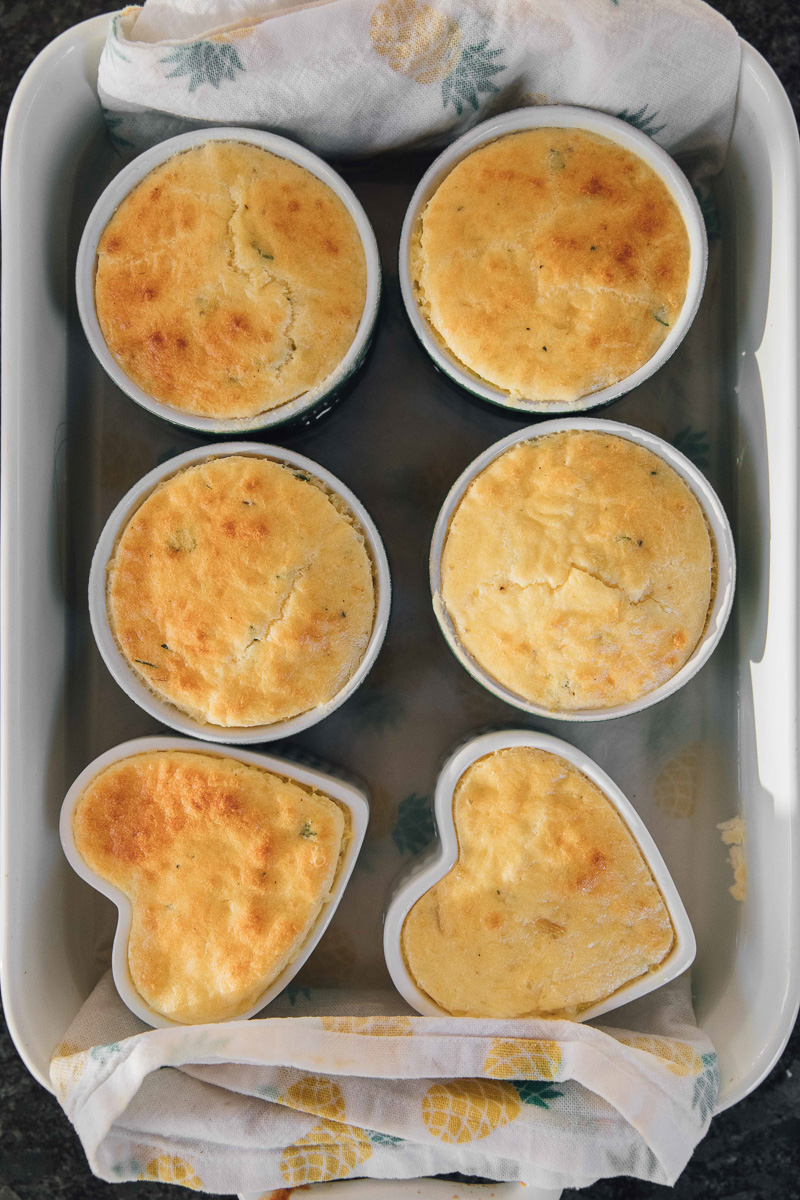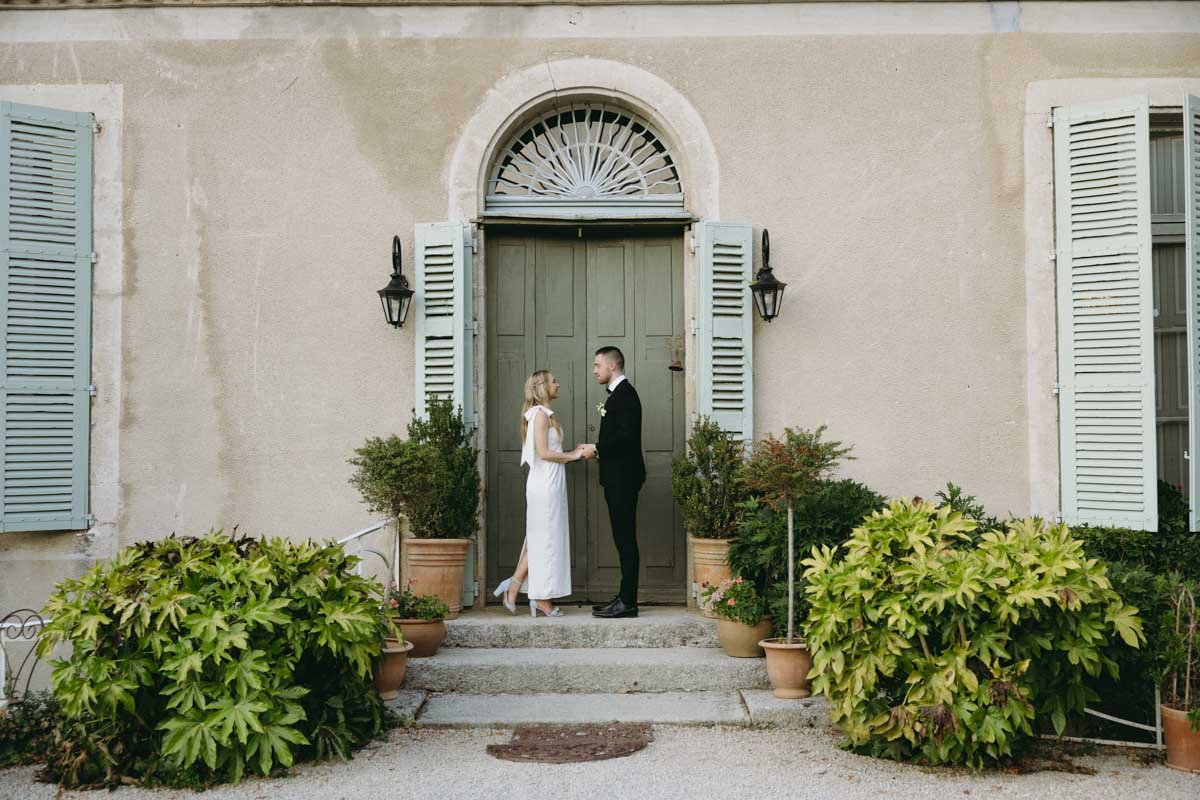This pillowy dish of air, cheese and leek emerges from a generously creamy cheese sauce. A true French classic, twice-baked goat’s cheese and leek vegetarian souffle is the perfect wintry balance of airy yet substantial and soul-warming.

Country Number 62: France
Bonjour! Comment ça va? Je m’ennuie – c’est à nouveau le confinement! Ahh lockdown – Covid has been a real merde hasn’t it? Thankfully, we were able to make our French dinner in between lockdowns, which meant we could have friends around and go the whole hog with wine, cheese starters, and a rhubarb clafoutis for dessert and not feel guilt over the gluttony. It was pretty glorious and we were feeling very inspired: as everyone knows, the French know how to cook, and they know how to host a good dinner party too.
Both Niccy and I have spent a decent amount of time in France. Combined we’ve visited Paris (obviously), along the southern border from Carcassonne to Montpellier, Nîmes, Arles, Avignon, Marseille and Nice, and up to Annecy and Alsace. I think France for both of us was one of those places that you dream about visiting your whole life, and once you have, it’s even better, more beautiful, more real, than what you could have imagined.
Everything about the country oozes culture: the cuisine, the language itself (which j’adore despite the fact that the Parisians definitely pretended not to understand when I made their ears bleed with my high-school French), the architecture, the art (visiting the Musée d’Orsay and the Louis Vuitton Foundation were transformative experiences), the jazz playing as one wanders the glittering streets.
Even the casual, sensual, attitude of the French in how they interact with one another: for an Antipodean pair whose cultures are famous for pavlova and shoeys, it was quite magical. Additionally, as Nic would happily warn you, I like to inform everyone how my middle name Vernede is a family name passed down from my Dad’s side, named after the village of St-Laurent-la-Vernède, where our family originated. Anyway, we just wanted to express notre admiration for this wonderful country. Enough of this panegyric: onto the food.

History of French Cuisine
French cuisine is steeped in tradition. From the Middle Ages, France, and particularly Pαris, blossomed as a cultural and economic centre. During the ‘Ancien Régime’, France developed a guild system of those who provided foods. Guild titles such as charcuterie or boulangerie had to be earned, and had strict quality regulations.
There was a stiff hierarchy within the culinary arts, and chefs could receive high acclaim both within the guilds and in the royal kitchens. Haute cuisine was developed during the 17th century under the chef La Varenne. La Varenne wrote Le Cuisinier François, known as the first true French cookbook, shaking up what was traditionally an orally transmitted art.
The French revolution of 1789 shook up not only the political order but the culinary as well. The guild system was abolished, restaurants became widespread, and the food itself changed. Gone were the lavish banquets to feed a hall-ful of people. They were replaced by a menu and single portions served to individuals at a table. In some ways this allowed for a more democratic feed: a greater number of people could afford to eat out in such a manner.
Yet at the same time, it removed the communal element that we find in family-style dining and share-plates that have become so popular again today. During this period, Marie-Antoine Carême, known as the world’s first celebrity chef, became renowned for his renovation of the French culinary scene and is known today for naming the five ‘mother’ sauces as hollandaise, bèchamel, velouté, espagnole, and tomato, as well as for creating the toque (the standard chef’s hat).

A lot of what we know of French cuisine today is the result of this invention of the restaurant and its menu, made famous and perfected by the French over the last two hundred years. Generally it boils down to drawing out the flavour of the highest-calibre ingredients, without over-embellishment. Fernand Point, known as the father of modern cuisine, famously said that in order to master a dish, one must cook it 100 times.
He also warned that if a chef was thin, the diner was in for a bad meal. He brought together two sides of French cuisine: 19th century extravagance and rich ingredients (think soufflé, vol-au-vent, and sugar-spun towers) and cuisine familiale: a lot of locally sourced ingredients and slow-cooked, one-pot dishes, such as boeuf bourguignon or confit de canard.
The 19th and 20th centuries saw the emergence of nouvelle cuisine, which had a turn towards light, fresh, and clear notes of flavour. This movement rejected overcomplication, shortened cooking time to preserve the natural flavour of the meat or vegetables, utilised fresh and local ingredients and dishes, shortened menus, rejected marinades and heavy sauces, modernised techniques, and became more innovative.
Today a mixture of haute and nouvelle cuisine are popular: people like a taste of both the old and new. But the tenants of French cuisine remain the same: draw out and enhance flavours. Simplicity is key. And of course, wine and cheese should be found at every good dinner party.
Popular French Vegetarian Dishes
While meat may often be the star of French cuisine, there are some standout vegetarian dishes.
- Soupe à l’oignon – French onion soup consisting of onions caramelised in sherry and then gratinéed with cheese and bread, which is then baked to form a crispy top layer.
- Cheese soufflé – coming from the French past participle meaning ‘having blown/puffed’, this baked egg dish consists of beaten egg whites lightly folded into a bechamel.
- Crème Brûlée – a dessert of rich custard topped with a torch-burnt sugar.
- Crêpe – let us not forget the humble crêpe, a thin flat pancake served either savoury (as a galette) with fillings such as cheese and mushroom, or sweet with toppings as simple as lemon and sugar, or more elaborate, for example the crêpes Suzette made with a sauce of caramelised sugar, butter, orange juice and zest, and Grand Marnier or another orange liqueur, served flambé style.
- Flamiche – a savoury quiche-like pie originating from Picardy, and served with a puff pastry tart with leeks, cream and cheese, and occasionally other vegetables.

Making this Vegetarian Souffle
Soufflés might seem scary, given how precariously they puff up and sink so easily, however if you follow the recipe to a tee then It’s actually straightforward and they will come out perfectly. We found that you do really need to give them that extra time to allow them to crisp a bit more on top: a nice crispy caramelised top is the way to go.
Note that these soufflés are twice-baked, so make sure to give yourself plenty of time to cook them the first time, let them cool, then re-bake them. They can be baked for the first time a day before serving.
Watch as we make vegetarian souffle in our very first cooking video!
How to make this vegetarian souffle with goat’s cheese and leeks

- Preheat the oven to 180C. Grease 8 x 250ml ramekins. Melt butter in a deep sauté pan, and add in onion and leek. Give a hearty season of salt and pepper, and sauté over a medium-high heat for 8 minutes or until soft and tender. Add in garlic, cook for a further minute, then add in wine, and cook for a further couple of minutes. Add in cream, and cook until reduced, a further 5 minutes or so.

2. While the onion and leek are cooking, melt butter in a medium saucepan over a medium heat. Once melted, add in flour and beat to make a roux. Cook for a couple of minutes, then gradually add in milk, beating all the while, until smooth and thickened. Remove from heat, then add in herbs, parmesan and goats cheese and mix until well-combined. Leave to cool for 5 minutes.

3. Once cooled, beat in egg yolks, and season well with salt and pepper. Add in onion and leek mixture. Whip egg whites to soft peaks. Add one third of egg whites to the main batter and mix thoroughly to loosen. Gently fold in the remaining egg white until just incorporated.

4. Spoon mixture evenly until ramekins. Place ramekins into a large baking dish and fill the dish with hot, not boiling water, until it reaches halfway up the ramekins. Bake for 25 minutes or until the soufflés are risen and lightly golden. Remove from oven and allow to cool for at least an hour. Slide a knife around the ramekins, then tip soufflé onto a gratin dish. Store in fridge until ready.

5. Heat oven to 220C. Sprinkle soufflés with remaining parmesan and pour over the cream. Bake for 12-15 minutes until puffed and golden. Grill for one minute, to ensure the top is properly crispy. Top with a sprig of parsley and greens or asparagus on the side.

Ingredient notes for Twice-Baked Goat’s Cheese and Leek Soufflé
- Leek – If leeks are not in season, replace with additional onion, and add sugar and balsamic to caramelise.
- White wine – this can be substituted with brandy if you prefer, or vegetable stock for a vege option, although it won’t have the same depth of flavour as alcohol.
- Goat’s cheese – substitute with feta if you want a cheaper alternative.

Serving suggestions for this vegetarian souffle
We served ours with a side of lightly cooked asparagus, but a bitter green salad with citrus would also be a nice accompaniment. For a soufflé like this, a dry white wine, either a sauvignon blanc or pinot gris, would go very nicely.
Other deliciously cheesy dishes to try
- Bajan Macaroni Pie Recipe: Baked Mac & Cheese
- Käsespätzle Recipe: Mac and Cheese from Austria
- Vegetarian Empanada Recipe from Argentina
Like this vegetarian souffle recipe? Pin it for later!







